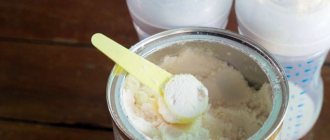How to teach a child to use a bottle - not every child agrees to eat from a bottle the first time. But it often happens that the mother has no other choice and the baby has to be accustomed to artificial feeding. This can happen due to a woman going to work early, having a serious illness, frequent absences from home, the inability to feed the child on time, or even a contraindication to breastfeeding.
In order for a baby to get used to eating from a bottle, a woman will need not only patience, but also ingenuity. To facilitate the process of getting used to IV, the tips given in our article will help, which will make the transition from breastfeeding to a bottle calm and comfortable for both the baby and his mother.
What is the reason for a child refusing a bottle?
It is normal for a baby to ignore the bottle. There's nothing scary about it. This happens because the child’s body contains the knowledge that its main diet should consist of breast milk, which the baby will receive not from a bottle, but from the mother’s breast.
It is for this reason that the child, on a subconscious level, reaches for the breast, and the nipple is much more convenient and pleasant for him than any nipple.
But often the reason that a baby refuses artificial feeding is not the bottle at all, but absolutely other reasons, which are that:
The child is not hungry - this is the most common reason that a toddler refuses a bottle, but for some reason parents do not pay attention to it. Here you should also take into account the fact that the need for the frequency and quantity of food intake depends on the age of the baby. Therefore, one should not be surprised if the baby, after reaching six months, begins to actively demand a bottle and drink from it with pleasure, although previously he refused it and denied it in every possible way;
The baby does not like the formula, tea or other food given from the bottle . Parents should understand that each infant formula has its own taste and sometimes it is very specific. It may be too sweet or even tasteless. Therefore, so that the baby can choose “his own”, he should be offered several types of baby food. And if you give a child tea, water or medicine from a bottle, and then food, he may not accept it at all, since he will associate it with something unpleasant and tasteless. Therefore, in the case of medications, it is better to give them in a different way or use ingenuity and imagination.
Hot or cold food
It should be remembered that the mucous membranes of a baby’s mouth are much more sensitive than those of adults. Therefore, the temperature of the infant formula should be around 36-37 degrees. These are the temperature indicators that mother's milk has. Therefore, this fluid temperature is the most normal for a child.
Inconvenient pacifier - a pacifier that parents like may not be to the taste of their child. He may not like its shape or the size of the hole through which the mixture enters. Sometimes the baby refuses the bottle, although he used to drink from it normally. This may happen because the parents bought a new nipple for the bottle, which is not the same shape as the old one. In addition, it can smell unpleasantly like rubber, interrupting the baby’s appetite.
Uncomfortable position and uncomfortable environment for feeding . The feeding position that is comfortable for mommy will not always be comfortable for the baby. You can try feeding him by sitting him in your arms, lying down, on the side, or in other positions. You may also need a change of environment to encourage your baby to start drinking from a bottle.
Perhaps one of the reasons described above is preventing the baby from getting used to artificial feeding; by eliminating it, parents will be able to accustom the child to a bottle.
The child does not eat formula
When breastfeeding is not possible, in order to provide the baby with all the necessary nutrients, artificial feeding or formula for feeding babies comes to the rescue. But in this case, mothers of formula-fed children often face a situation where the child does not eat the formula and refuses the bottle. Then parents begin to worry and sometimes panic, because, in their opinion, the baby is hungry, malnourished and does not receive enough necessary microelements and vitamins, which are so necessary for the child’s full growth and development.
In fact, there is a specific reason why your baby refuses formula. Let's look at the main reasons why infants do not want to eat formula.
So, firstly, if your baby is not eating well or is refusing a bottle of formula altogether, this may indicate that he is not hungry yet. In other words, his stomach had not yet digested the previous portion of the mixture. The fact is that the formula is somewhat more nutritious than breast milk, so it takes longer to digest in the baby’s digestive system. In order to normalize the feeding process, it is necessary to maintain certain intervals between formula feedings. The recommended interval is 3-4 hours.
The second reason why a baby spits out formula may be that he simply doesn't like the taste of it. This is a fairly common occurrence. Today, the baby food market offers more than 80 types of formulas, and each of them has its own specific taste. Therefore, it is not surprising that the baby may find it unpleasant. In this case, it is better for you and your pediatrician to try to find a different formula.
The third reason why a baby may refuse formula may be teething. After all, everyone knows that during this period he experiences painful sensations, his general condition worsens. In this case, digestive disorders may occur (diarrhea, vomiting, nausea, fever, etc.). The baby experiences the main pain in the gum area, which intensifies with sucking. Therefore, he can refuse porridge, which he used to love very much. In this case, you should just wait out the difficult period. Ease your baby's suffering with special pain-relieving gels that are applied directly to the gums. Such gels are created specifically for children whose teething is painful. As a rule, when the tooth has erupted, the baby’s appetite returns.
The fourth reason why a child does not take formula may be the wrong nipple for the bottle or its change. Due to the very large hole in the nipple, milk (formula) can flow very abundantly and quickly, and the baby will choke during feeding and swallow excess air. However, a hole that is too small may also not be pleasant for the baby, as it forces him to make an effort to suck out the milk. Therefore, before buying a pacifier, it is better to make sure that it is suitable for your age.
Other reasons for a baby’s refusal to give formula may include a sore throat, tummy pain, or inflammation of the ear.
Your rating Rating: 0 (0 votes)
Other recommendations if your baby refuses a bottle
If you've followed the steps above and your baby still refuses the bottle, don't be discouraged. There are many other ways to wean your baby and introduce him to a bottle. Here are some simple tricks you can add to your bottle feeding routine. [2]
1. Remind your child about his mother.
Sometimes a child can be fed by someone other than his mother - a father, grandmother or, for example, a nanny. If baby fusses during bottle feeding, try wrapping the bottle in something that smells like mom, such as a piece of clothing or fabric. This will make it easier to feed the baby when mom is not around.
2. Try to maintain skin-to-skin contact while bottle feeding.
Some babies have a harder time weaning due to their need for skin-to-skin contact. Try feeding your baby when he is only in a diaper, lean him against you and hold him in a comfortable position. However, some babies feed better from a bottle in the exact opposite position than when they were breastfed. For example, there is a position with bent legs. Place the baby on your bent knees, facing you, with the baby's legs pointing towards your stomach. During feeding, the baby will be able to look at you and thus communicate with you. If your baby refuses a bottle, experiment to see which works best.
3. Move while feeding.
Sometimes all it takes is a little rocking or walking to get your baby to take the bottle. The next time your baby starts crying while bottle feeding, try moving a little rhythmically to calm him down.
4. Try changing the temperature of the milk.
If your baby still doesn't want to take the bottle, check to see if the milk in the bottle is too hot or cold. Before feeding, drop a little warmed breast milk on the inside of your wrist to check the temperature. The milk should be warm, but if it seems hot to you, just place the bottle briefly under running cold water.
What to do if your baby won't eat formula from a bottle?
The first thing you need to do is be patient. Before you lies a tiny person who needs to be accustomed to his first independent experience. Not all babies quickly get used to feeding, especially if their mother is not around.
If your child does not want to eat formula from a bottle, then you should follow the following instructions, which will definitely help. This is a plan for further action in case the baby asks only for the mother's breast.
What to do if your baby won't eat from a bottle:
- A good way to help your little one is to divide the meal into two stages. The first half of the meal is breastfed, the second is bottle feeding. So, some mothers take the baby in their arms, exposing the breast, and then sit on a chair to change it with a bottle.
- sometimes you just need to distract the child so that he does not notice the substitution. Get up, walk around with the baby in your arms, you can sing a song or tell something, and then bring the bottle to his lips. He will think that this is his mother’s breast and will begin to suck it with pleasure.
- Never insist that the entire contents be drunk completely. Let the baby eat as much as he wants and can. If he pushed the bottle away the first time, don't be angry. This behavior of a baby should not be regarded as bad.
The only argument why a child refuses a bottle with formula is that he does not like the new method of feeding. In this case, it is better to choose a pacifier that is shaped like your nipple. This will be more familiar for the baby, and the sensations will become familiar.
A child does not eat goat milk formula well - what can I do to help?
Babies eat well and gain weight on goat milk-based formula, which pleases not only moms and dads, but also pediatricians. But sometimes the child refuses goat formula. What are the reasons for poor appetite in infants and why does the child not want to eat goat formula?
— Polina Aleksandrovna, how do the feeding options differ?
- There are three types of feeding of children in the first year of life - breast, artificial and mixed.
- Breastfeeding, also called natural, means the baby is fed only milk from the mother's breast.
- A bottle-fed baby receives 100% milk nutrition from an artificial formula.
- With mixed feeding, one part of the baby’s diet is breast milk, the other is formula. In this case, supplementary feeding can be organized in different ways: 90% mother's milk and 10% baby formula, or 50/50 and in a different ratio - it depends on the reasons why the formula is introduced.
— Which children are usually recommended to use goat milk formula?
— The most obvious option is when mom or dad has a predisposition to allergies, but the child has not yet manifested an allergy. For such children, goat milk formula is prescribed first, because, unlike cow milk formula, it is less conducive to the development of allergic reactions.
Goat formula can also be prescribed to small children with a not very good appetite, since goat milk is absorbed better and, accordingly, the child can be fed with a smaller portion.
Generally speaking, the mixture is not medicinal, so it is quite suitable for all healthy babies.
— Why doesn’t the child eat goat milk formula or doesn’t eat it well?
- This is possible when switching from breastfeeding to artificial feeding. The baby is getting used to feeding from the breast, and the bottle will be unusual for him. The baby needs time to adapt. In addition, when breastfeeding, it satisfies the needs not only for nutrition, but also for communication with the mother. Therefore, for maximum comfort for the baby when feeding from a bottle, the same position is recommended as when breastfeeding: the mother should try not to engage in extraneous activities and maintain the most familiar environment, the same as when breastfeeding. It is important to select a bottle and pacifier that is age-appropriate so that the flow of formula is not too large or too small.
— How can I easily introduce a formula with goat’s milk when switching from a formula with cow’s milk?
— When a new product is introduced to a small child, the main rule is gradualism. The child’s usual formula is replaced with a new mixture little by little, starting from 15 to 30 ml at different ages. Every day the share of the new mixture in the diet increases and is brought up to the age norm. In about one week, the baby can be completely switched to a new formula. As a rule, if a formula with cow's milk is absorbed well, then a formula with goat's milk is absorbed without problems, the transition occurs quite quickly and favorably. However, you should adhere to the following rules:
- introduce a new mixture in the first half of the day to monitor possible reactions;
- observe the child’s behavior and well-being - record anxiety, rumbling in the stomach or other discomfort, the presence or absence of skin rashes and changes in stool (thinness, increased frequency, streaks of mucus or blood).
Adverse reactions to the introduction of a new formula from the skin or gastrointestinal tract in a child may be symptoms of an allergy to the formula. In this case, the new mixture should be removed from the baby’s diet and contact a pediatrician.
— Why does a child refuse one brand of goat milk formula, but drink another with pleasure?
— The taste of the mixture is the most striking moment that can alert the baby, but if the transition occurs from one goat milk mixture to another, then there should be no problems. The baby may have a reaction to the components in the new mixture. In this case, you need to cancel the new formula and no longer offer it to the child - and together with your doctor, try to find out the cause of the negative reaction.
- Suddenly the child began to refuse formula - what are the reasons for poor appetite?
— Refusal of formula is not due to the fact that the child has stopped loving it or he no longer likes its taste. Most likely, changes have occurred in the child’s body, due to which the appetite has decreased - malaise, an incipient illness, poor health due to hot weather.
— What if the child doesn’t finish the goat mixture?
— It happens that a child does not finish the formula if the amount of food is calculated incorrectly, for example, instead of 220 ml of formula, he needs 200 ml. Cases when a child eats less than his norm, but gains weight well and there are no problems, are extremely rare, this is an individual feature: nutrients are absorbed better, the metabolism is more active and the baby gets enough nutrition that he eats.











